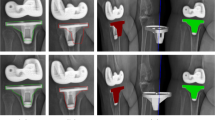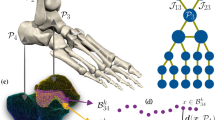Abstract
A new method for prosthetic component segmentation from fluoroscopic images is presented. The hybrid approach we propose combines diffusion filtering, region growing and level-set techniques without exploiting any a priori knowledge of the analyzed geometry. The method was evaluated on a synthetic dataset including 270 images of knee and hip prosthesis merged to real fluoroscopic data simulating different conditions of blurring and illumination gradient. The performance of the method was assessed by comparing estimated contours to references using different metrics. Results showed that the segmentation procedure is fast, accurate, independent on the operator as well as on the specific geometrical characteristics of the prosthetic component, and able to compensate for amount of blurring and illumination gradient. Importantly, the method allows a strong reduction of required user interaction time when compared to traditional segmentation techniques. Its effectiveness and robustness in different image conditions, together with simplicity and fast implementation, make this prosthetic component segmentation procedure promising and suitable for multiple clinical applications including assessment of in vivo joint kinematics in a variety of cases.






Similar content being viewed by others
References
Banks SA, Hodge WA (1996) Accurate measurement of three-dimensional knee replacement kinematics using single-plane fluoroscopy. IEEE Trans Biomed Eng 43(6):638–649
Batten CF, Holburn DM, Breton BC, Caldwell NHM (2001) Sharpness search algorithms for automatic focusing in the scanning electron microscope. Scanning 23(2):112–113
Bifulco P, Cesarelli M, Allen R, Sansone M, Bracale M (2001) Automatic recognition of vertebral landmarks in fluoroscopic sequences for analysis of intervertebral kinematics. Med Biol Eng Comput 39(1):65–75
Canny J (1986) A computational approach to edge detection. IEEE Trans Pattern Analysis Mach Intell 8(6):679–698
Chan CL, Katsaggelos AK, Sahakian AV (1993) Image sequence filtering in quantum-limited noise with applications to low-dose fluoroscopy. IEEE Trans Med Imag 12(3):610–621
De La Fuente M, Ohnsorge JAK, Schkommodau E, Jetzki S, Wirtz DC, Radermacher K (2005) Fluoroscopy-based 3-D reconstruction of femoral bone cement: a new approach for revision total hip replacement. IEEE Trans Biomed Eng 52(4):664–675
Dennis DA, Komistek RD, Hoff WA, Gabriel SM (1996) In vivo knee kinematics derived using an inverse perspective technique. Clin Orthop Relat Res 331:107–117
Domokos C, Kato Z (2010) Parametric estimation of affine deformations of planar shapes. Pattern Recogn 43(3):569–578
Elder JH, Zucker SW (1998) Local scale control for edge detection and blur estimation. IEEE Trans Pattern Analysis Mach Intell 20(7):699–716
Ghosh P, Sargin ME, Manjunath BS (2009) Robust dynamical model for simultaneous registration and segmentation in a variational framework: a Bayesian approach. In IEEE 12th International Conference on Computer Vision. pp 709–716
Hirokawa S, Hossain MA, Kihara Y, Ariyoshi S et al (2008) A 3D kinematic estimation of knee prosthesis using X-ray projection images: clinical assessment of the improved algorithm for fluoroscopy images. Med Biol Eng Comput 46(12):1253–1262
Hoff WA, Komistek RD, Dennis DA, Gabriel SM, Walker SA (1998) Three-dimensional determination of femoral-tibial contact positions under in vivo conditions using fluoroscopy. Clin Biomech 13(7):455–472
Hurschler C, Seehaus F, Emmerich J, Kaptein BL, Windhagen H (2008) Accuracy of model-based RSA contour reduction in a typical clinical application. Clin Orthop Relat Res 466(8):1978–1986
Kaptein BL, Valstar ER, Stoel BC, Rozing PM, Reiber JHC (2003) A new model-based RSA method validated using CAD models and models from reversed engineering. J Biomech 36(6):873–882
Kaptein BL, Valstar ER, Stoel BC, Reiber HC, Nelissen RG (2007) Clinical validation of model-based RSA for a total knee prosthesis. Clin Orthop Relat Res 464:205–209
Mahfouz MR, Hoff WA, Komistek RD, Dennis DA (2003) A robust method for registration of three-dimensional knee implant models to two-dimensional fluoroscopy images. IEEE Trans Med Imag 22(12):1561–1574
Mahfouz MR, Hoff WA, Komistek RD, Dennis DA (2005) Effect of segmentation errors on 3D-to-2D registration of implant models in X-ray images. J Biomech 38(2):229–239
Narvekar N, Karam L (2011) A no-reference image blur metric based on the cumulative probability of blur detection. IEEE Trans Image Process 480:1–7
Oprea A, Vertan C (2007) A quantitative evaluation of the hip prosthesis segmentation quality in X-ray images. In International Symposium on Signals, Circuits and Systems. pp 1–4
Perona P, Malik J (1990) Scale-space and edge detection using anisotropic diffusion. IEEE Trans Pattern Analysis Mach Intell 12(7):629–639
Pratt WK (2007) Digital image processing. Wiley, New York
Rockafellar TR, Wets RJB (2004) Variational analysis. Springer, Germany
Sapiro G (2002) Geometric partial differential equations in image analysis: past, present, and future. In: Proceedings of international conference on image processing 3:1–4
Sethian JA (1999) Level set methods and fast marching methods. Cambridge University Press, London, p 404
Tashman S, Anderst W (2003) In vivo measurement of dynamic joint motion using high speed biplane radiography and CT: application to canine ACL deficiency. J Biomech Eng 125(2):238–245
Tersi L, Fantozzi S, Stagni R (2010) 3D elbow kinematics with mono-planar fluoroscopy: in-silico evaluation. EURASIP J Adv Signal Process 2010(1):142989
Tsomko E, Kim HJ, Izquierdo E (2010) Linear Gaussian blur evolution for detection of blurry images. IET Image Proc 4(4):302
Varshney KR, Paragios N, Deux J, Kulski A, Raymond R, Hernigou P, Rahmouni A (2009) Postarthroplasty examination using X-ray images. IEEE Trans Med Imag 28(3):469–474
Yamazaki T, Watanabe T, Nakajima Y, Sugamoto K, Tomita T, Yoshikawa H, Tamura S (2004) Improvement of depth position in 2-D/3-D registration of knee implants using single-plane fluoroscopy. IEEE Trans Med Imag 23(5):602–612
You BM, Siy P, Anderst W, Tashman S (2001) In vivo measurement of 3-D skeletal kinematics from sequences of biplane radiographs: application to knee kinematics. IEEE Trans Med Imag 20(6):514–525
Zhao D, Banks SA, D’Lima DD, Colwell CW, Fregly BJ (2007) In vivo medial and lateral tibial loads during dynamic and high flexion activities. J Orthop Res 25(5):593–602
Zuffi S, Leardini A, Catani F, Fantozzi S, Cappello A (1999) A model-based method for the reconstruction of total knee replacement kinematics. IEEE Trans Med Imag 18(10):981–991
Acknowledgments
This project was supported by the research grant “A multimodal approach to study the biomechanics of healthy and pathological knee” (PRIN 2008).
Author information
Authors and Affiliations
Corresponding author
Additional information
C. Corsi and R. Stagni contributed equally to this work.
Rights and permissions
About this article
Cite this article
Tarroni, G., Tersi, L., Corsi, C. et al. Prosthetic component segmentation with blur compensation: a fast method for 3D fluoroscopy. Med Biol Eng Comput 50, 631–640 (2012). https://doi.org/10.1007/s11517-012-0884-x
Received:
Accepted:
Published:
Issue Date:
DOI: https://doi.org/10.1007/s11517-012-0884-x




